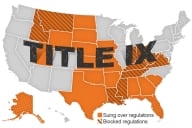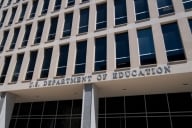You have /5 articles left.
Sign up for a free account or log in.
Alaska governor Mike Dunleavy, whose state faces a $1.6 billion deficit, is proposing to cut $310 million from the state’s education system -- including a jaw-dropping 41 percent cut to the University of Alaska System.
The planned reduction represents the largest of any state agency.
Dunleavy’s plan comes alongside a proposed $20 million funding increase for the state’s 13 public community colleges, known in Alaska as “community campuses.”
The new budget, announced Wednesday in Juneau, is part of Dunleavy’s plan to trim the deficit by $1.3 billion. The plan includes cutting nearly one-fifth of the budget of the state Department of Education and Early Childhood Development, which includes the university system.
University of Alaska president Jim Johnsen told the Anchorage Daily News that the proposed cut is the largest in the university system’s 100-year history and could force its campuses to fire about 1,300 faculty and staff members. Johnsen said several research efforts would also be in jeopardy.
In a statement, Johnsen said Dunleavy’s budget, if approved, would devastate the university system, forcing him to propose “deep cuts for every UA campus.” He said the system had already been operating under leaner budgets in four of the last five years.
“Cuts at this level cannot simply be managed or accommodated,” he said. “If this budget passes the Legislature, it will devastate university programs and services, and the negative effects will be felt in communities across the entire state.”
The lower spending, Johnsen said, “will hurt Alaska’s economic competitiveness now and long into the future.”
A budget summary posted on Dunleavy’s official site said the reduced spending would allow the system to “focus on core programs and educational services” while encouraging it to focus on instruction in community campuses operated by the state's three system branches.
The proposal would also hit public K-12 education, slashing about one-fifth of operating expenses at the Anchorage School District, for example. Starr Marsett, president of the Anchorage School Board, called it “the dismantling of public education as we know it.”
Dunleavy also wants to zero out $3.1 million in state funding for a multistate medical education program run out of the University of Washington School of Medicine that trains physicians to serve in Alaska and elsewhere in the West. Alaska is one of several states without a medical school.
Over all, he wants to withdraw a $154 million state subsidy from the university system while carving out $20 million more for community campuses, which he said operate more efficiently, costing the state just $8,210 per student, compared to $25,336 per student at the state’s four-year campuses.
Cathy Sandeen, chancellor of the University of Alaska Anchorage, the largest institution in the system, didn’t sugarcoat the proposed cut.
“It is very large,” she said.
Sandeen noted that legislators will almost certainly push back on Dunleavy’s budget proposal. But in the end, she said, she and other university leaders are preparing for leaner times -- they plan to meet today to discuss staffing and program reductions.
“A cut of this magnitude will undoubtedly result in work-force reductions and major restructuring of programs,” she said. “There are some things that this will force us to look at that will make us better, but we will definitely be smaller and we’ll definitely be doing things differently when we come out the end of this.”
Sandeen, who came to Alaska from the University of Wisconsin System, said she’s no stranger to statewide cuts to higher education -- while in Wisconsin, she recalled, her campus labored under both a tuition freeze and a 27 percent state funding cut. “I come into this with experience,” she said.
Alaska’s community campuses merged with the four-year system in the 1980s, Sandeen said, and the arrangement has worked well. “We like having a full arc of educational pathways available to our students.” But carving the community campuses out as a separate system “could certainly work” as well, she said, if the new system can do a better job offering shorter-term credentials that support work-force training. “If one believes in focus and specialization being a good thing, this new structure would enable that, perhaps, a little better.”
Sandeen noted that she’s a product of California’s once well-funded public university system and later worked in Silicon Valley. “I see the economic power of quality universities,” she said, “both in generating new knowledge, new industries and providing the workforce that employers need.”
‘A Big Step Backwards’
Thomas Harnisch, director of state relations and policy analysis at the American Association of State Colleges and Universities, warned against balancing state budgets “on the backs of students.”
“People need to remember that cutting higher education funding is a policy choice,” he said. “This is not inevitable.”
Harnisch predicted that the steep cuts will make it difficult over the next few years ”to lure the best and the brightest” to work in Alaska’s public universities. “Education is a community, and people certainly talk to each other.”
He recalled that in 2011, in the height of the recession, New Hampshire moved to make similar cuts to its higher ed system, slashing funding by nearly 50 percent in one year. “It took them some time to recover from that,” he said.
Dunleavy, a Republican elected last November, previously served as a state senator since 2012. He has described the new budget as “an open and straightforward approach to budgeting that works to tackle Alaska’s overwhelming fiscal challenges.” In online postings, he has called the proposal “An Honest Budget” that preserves state reserves and doesn’t repeat past years’ deficit spending.
But Harnisch said cutting higher ed so deeply will hurt the state’s efforts to diversify its economy, which relies heavily on oil revenues.
“Texas learned its lesson in the 1980s,” he said. “They made a conscious effort to go from a one-dimensional economy” to a diverse one that bolstered state spending on education. “If Alaska is going to grow and diversify its economy, it needs to invest in its public colleges and universities -- and this cut is a big step backwards.”
The medical training program, known as WWAMI, draws its name from the five states served: Washington, Wyoming, Alaska, Montana and Idaho.
It trains 80 Alaska students at a time at the University of Alaska Anchorage, via digital instruction from he University of Washington School of Medicine. Students are dually enrolled at the University of Alaska and University of Washington. They complete foundational course work both on campus and in communities. Graduates who practice medicine in Alaska qualify for loan forgiveness if they work in rural areas of the state for three years or elsewhere in Alaska for five years.
Dunleavy has said that only about 55 percent of WWAMI borrowers are licensed physicians practicing medicine in Alaska, and that the program “has not proven effective at meeting the demand for new physicians, despite a significant state investment over the years.” He said the percentage of program graduates practicing in Alaska “continues to decrease.”
In a detailed budget analysis the governor posted online, he said that from 2014 to 2018, the percent of graduates practicing in Alaska dropped from 84 percent to 61 percent.
But the University of Washington School of Medicine’s Suzanne Allen said those figures are misleading, since many students who train with WWAMI elsewhere in the five-state region end up practicing in Alaska. The percentage of total WWAMI students who end up practicing in Alaska, she said, is closer to 80 percent, not 61 percent.
“We certainly feel like we make a significant contribution to the physician work force in that state,” she said. “Our focus is really on creating a rural primary-care work force to meet the needs of patients in Alaska.”
The program actually originated in Alaska in 1971, with 10 medical students. Since then, it has produced about 350 Alaska graduates, she said. “We feel like the training opportunities we provide for medical students contribute in a positive way to them coming back and actually practicing in the state.”
Johnsen, the system president, said today's emergency meeting with the chancellors will help them propose reductions to the Board of Regents, which meets Feb. 28.
“We are heading into uncharted territory with lots of uncertainty ahead,” Johnsen said.








